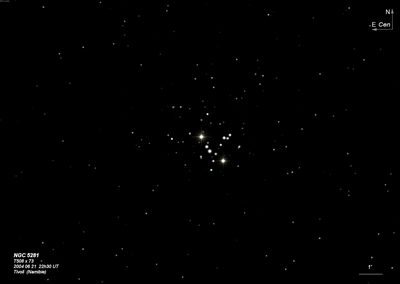
Nicolas-Louis de Lacaille discovered NGC 5281 = Lac I-7 = D 273 = h3531 in 1751-1752 during his expedition to the Cape of Good Hope. With a 1/2" telescope at 8x he noted a "small indistinct spot." James Dunlop described D 273 as "a curved line of small stars, about 1.5' long, with a star of the 7th mag in the north extremity; a group of extremely minute stars on the preceding side of the crescent, and a multitude of very minute stars extended preceding and following." Dunlop sketched the cluster (Fig. 11) and observed it 7 times. John Herschel called it (sweep 596) "a brilliant, compact, milky way cluster. Rich; irreg fig; gbM; 10' stars 10, 11 and 12m."
300/350mm - 14" (4/4/16 - Coonabarabran, 178x): very bright, striking cluster including a 2' string containing (from southwest to northeast) four stars mag 8.4, 7.9, 8.5 and 6.6 (at the northeast end). A 2' linear chain of 7 mag 10-11 stars intersects these bright stars. The central 4'-5' region contains ~50 stars, but many stars are scattered outside this region, extending the size of roughly 10'. NGC 5269 (probably an asterism) lies 12.5' W.
400/500mm - 18" (7/6/05 - Magellan Observatory, Australia): this large, rich cluster is striking at 128x. A curving 2' string of four stars mag 6.6-8.6 oriented SW-NE dominate the view, with a pale yellow star and an orange star at opposite ends adding color. Overall, perhaps 150 stars are visible (many mag 11-12) in an irregular 10' region although the boundaries are arbitrary as the cluster blends into the surrounding fields. Most of the brighter stars are within a 3' region and in fact the catalogued diameter is only 5'. At 228x, another fainter layer of 15th magnitude stars emerged from the background.
Notes by Steve Gottlieb